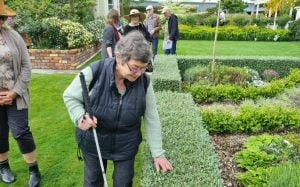
How to Design a Sensory Garden for Someone Living with Dementia
In the pursuit of health and holistic well-being, we sometimes overlook the profound benefits hidden in the most serene corners of our earth. Enter sensory gardens—vibrant, dynamic spaces that captivate the senses, invigorate the mind, and rejuvenate the soul. Now, imagine harnessing this power for someone you love who is experiencing dementia, offering them not just a slice of nature but a sanctuary calibrated to engage and soothe.
Our team at Park Place at Winghaven is highlighting the therapeutic benefits of sensory stimulation that stem from these gardens and sharing tips to create your own sensory garden for your family member.
What is a Sensory Garden?

Sensory gardens are crafted landscapes bursting with elements intended to engage the five senses. They are often celebrated for their diverse palettes designed to delight, comfort, and energize the visitor. They are more than mere gardens; they are experiences in themselves, tailored to evoke subtle emotions and reignite the wonder of our surroundings.
When designed for individuals with dementia, sensory gardens become pathways to memory, wellsprings of joy, and fortresses of familiarity. For someone grappling with the disorientation of cognitive decline, sensory gardens represent safe havens of familiarity.
Uncovering the Therapeutic Benefits
Creating and interacting with sensory gardens, whether in community settings or private spaces, contributes to the reminiscence and cognitive engagement crucial to caring for individuals with dementia. Sensory gardens are spaces for gentle therapy, not just in the physical exercises they offer but also through emotional resonance and the prompting of cherished memories.
Studies show that both physical and visual access to nature:
- Accelerates recovery from illness
- Decreases stress and reduces blood pressure
- Supports the regulation of circadian rhythms, enhancing the sleep/wake cycle
- Facilitates natural vitamin D absorption through brief sunlight exposure, which is crucial for strong bone health
Engaging Each Sense with Purpose
Sight – The vibrant blooms and luscious greenery in a sensory garden are not just a treat for the eyes; they are vital cues that stimulate recognition and recall. Familiar plants can channel one’s thoughts back into the warmth of childhood, peppering reality with nostalgia.
Sound – The gentle rustling of leaves, the patter of a cascading stream, or the low hum of conversation are all auditory touches that infuse the space with a stable, comforting tone. For a person with dementia, consistent yet non-intrusive sounds can carve out spaces that feel secure and predictable.
Smell – Scents can be powerful triggers, unraveling a tapestry of long-forgotten memories. A rose’s tender perfume carries whispers of romance, while the spiciness of an herb garden can summon the tables of Grandma’s kitchen. In essence, the fragrances in a sensory garden are catalysts for memories, facilitating journeys through time and self.
Taste – The culinary unit in a sensory garden – often an array of herbs and edible flowers – coaxes inquisitive palates and encourages exploration. Individuals can forge tangible connections with their immediate space by indulging in these tastes, grounding themselves in the present moment.
Touch – The tactile nature of a sensory garden affords countless opportunities for interaction. Whether it’s the cool press of a stone against warm skin, the springiness of a well-kept lawn, or the resilience of a gnarled tree trunk, these sensations provide vital feedback to a mind often left to wander in the shadowlands of dementia.
Each component of a sensory garden is thoughtfully orchestrated to harness the healing potential of sensory stimulation, offering a repertoire of tools for coping, reminiscing, and, most importantly, thriving.
Designing Your Own Sensory Garden

Creating a sensory garden is not just a task; it is an act of devotion, a testament to the belief in the fathomless healing of the natural world. Here’s how you can craft your own sanctum for sensory stimulation and exploration, designed especially for your family member with dementia.
Selecting the Right Space
The first step is to choose a location brimming with natural light and a variety of potential elements. It could be a corner of your backyard, a section of your balcony, or a small plot in a community garden. The key is the space’s accessibility and ability to transform.
Essential Elements to Include
- Orientation. Individuals with dementia frequently have trouble remembering their destinations and origins. That’s why creating a garden designed with visual cues to aid orientation can empower them, foster a sense of autonomy, and boost their self-confidence.
- Accessibility. Eliminating physical and mental obstacles is crucial to making your garden welcoming to people with dementia. Create clear paths that guide individuals through the garden, avoiding too many options and turns.
- Socialization. Improve the lives of individuals with dementia by fostering opportunities for socialization and interaction with friends, family, children, pets, and caregivers. This could mean adding a bench in your sensory garden to encourage relaxation and connection.
- Safety. Lastly, safety is essential to a garden’s usability. Addressing all potential safety concerns during the garden’s planning phase is crucial to ensuring that individuals can move independently through it without any hazards.
—
Designing a sensory garden for your family member with dementia may seem like a small step, but its impact on sensory stimulation is vast. To learn more about our memory care community in O’Fallon, Missouri, and how we can help your family member thrive, visit our website or contact a member of the Park Place at Winghaven team.